How to organize watering of flowers while on vacation?
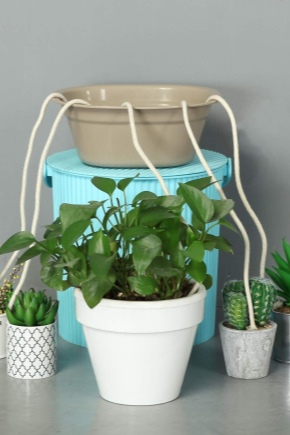
Sometimes it happens that you need to leave for a long time, and there is no one to water the indoor flowers in the absence of the owners. What to do in this situation? It's very simple: plants need to build an automatic irrigation system.
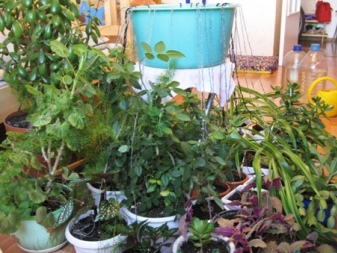
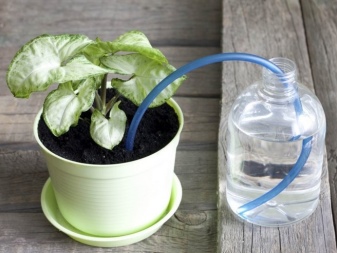
How to prepare indoor plants for vacation?
"Green pets" are able to survive the absence of moisture for a period of 7 to 20 days without much stress, although the specific period depends on the type of plant. Therefore, if you are planning to leave for no more than 2 weeks, you can simply take some measures.
- Remove all existing flowers and buds, as well as about 1/5 of the leaves, thereby reducing the evaporation area.
- Remove the flowerpots from the windowsills, move them into the back of the room, cover the curtains to avoid direct sunlight on the plants.
- Place all containers with flowers side by side, as closely as possible - this will help to form a certain microclimate in this area, namely, increased air humidity. Put wet moss, expanded clay next to them, place basins of cold water around them. On the day of departure, water the plants, increasing the fluid rate by about 1/3
- If you decide to feed the "green pets", do it no earlier than two weeks before departure.
- Flowers, especially capricious and demanding to water, cover with plastic bags, fixing them with rubber bands on the pots.
- Remember that when choosing a container for planting a houseplant, give preference to clay and ceramic options, since it is in them that the flowers more easily tolerate the lack of timely watering.
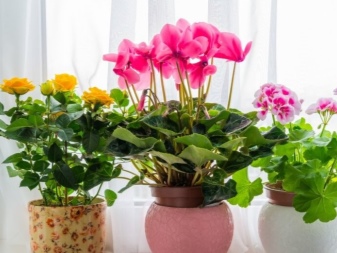
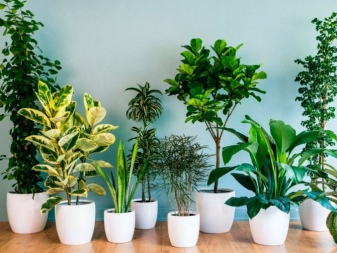
As you can see, most of the preparatory measures are aimed at introducing plants into a kind of suspended animation in order to suspend their vital processes and reduce the need for moisture.
Arrangement of autowatering
When you leave for a long time, it would be wrong to leave flowers without watering at all - they will all die, even the most persistent ones. In this case, you will have to organize automatic watering. The system can be purchased in a store or made by hand.
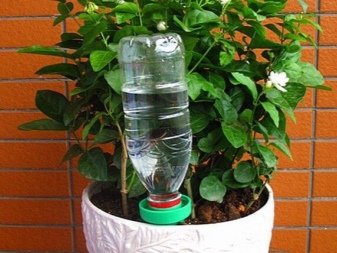
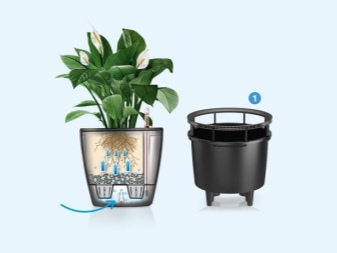
Purchased system
The simplest design is the so-called Aqua Globes. It is a blown glass ball resembling a flask with a narrow conical tube. The device is ideal for all indoor flowers, including curly ones.
The design works as follows:
- the ball is filled with water, turns over and is inserted into the ground with its thin neck;
- when the soil dries up, oxygen begins to be released, and with such a reaction, the ball releases the required amount of liquid into the soil;
- as soon as there is enough moisture for the plant, a vacuum is created in the ball, and the water stops oozing.
One ball of Aqua Globes can provide the plant with water for two weeks.

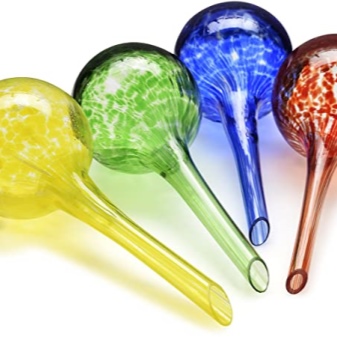
The next option is wick irrigation. There are special drainage holes in the bottom of the pot - this is where wicks made of synthetic porous material are inserted. A container with a flower is installed on a reservoir with water, the cords are lowered into it, and then the liquid rises through them and gets to the root system of the plant that wants to "drink". The essence of the method is that each flower receives moisture when it needs it, and in the required amount.However, remember that this method is not suitable for plants whose roots are located in the upper layers of the soil, as they simply will not reach the wicks placed below.
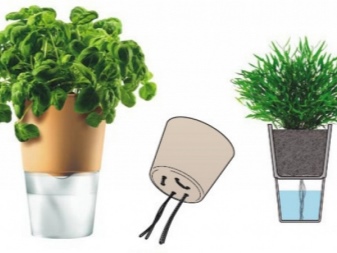
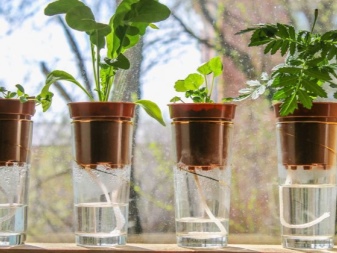
Another device is “smart” automatic irrigation systems. The principle of their work is as follows: water is collected in a large reservoir and fed into flower pots through built-in pipes. The distribution of liquid is regulated, and each plant receives exactly as much moisture as it needs at the moment.
Components of a "smart" system:
- a container for water and hoses for its supply;
- special tips that are inserted into the ground;
- timer for adjusting the frequency of watering (you can set it for a certain number of minutes and time of day);
- a distributor responsible for the consumption of liquid;
- soil moisture level sensor (in the most advanced devices, it is his "responsibility" to set the watering time);
- pump that pumps up water.
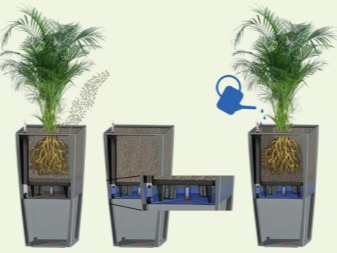
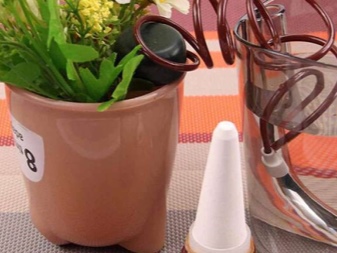
The last purchase option that we want to consider is a planter with an automatic watering system. In appearance it resembles an ordinary flower pot. The device is equipped with a built-in water container, as well as special wicks and an indicator tube. Most of these systems work with conventional drainage - expanded clay, gravel, vermiculite, but some manufacturers offer special drainage mixtures.
Interestingly, a flower in such a "smart" pots needs to be watered only three times a year - it is enough just to periodically replenish the reservoir with water. This device can be considered the best in the long and frequent absence of the owners of the house.

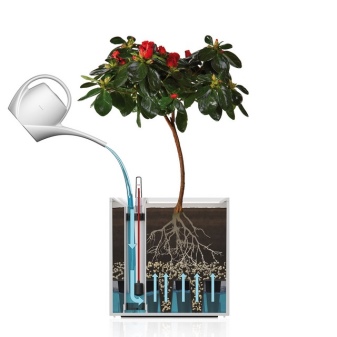
Homemade options
If you want to arrange an automatic watering system for indoor flowers with your own hands, you can use one of the simple methods.
A simple device is created using an ordinary plastic bottle of any volume (it should be understood that if you are leaving for one or two weeks, a small container will suffice, and if for a month it is better to take a larger bottle).
Algorithm for assembling a structure:
- take the selected bottle with a lid;
- fill it with water;
- make a hole in the lid;
- insert the bottle into the soil with the neck down, fix it well;
- also make a few holes in the bottom of the bottle or cut it off altogether to increase the air pressure.
This method is very primitive and not very reliable: the water supply of the plant will not be regulated in any way, and the flower will either be waterlogged or not fully watered.
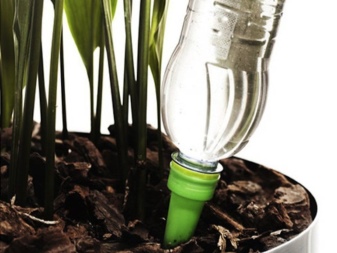
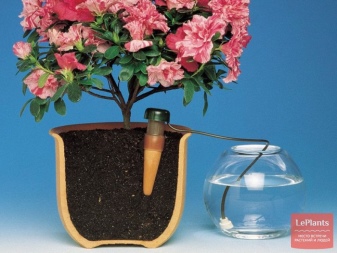
To avoid this and achieve optimal moisture yield, you will have to experiment with the size of the hole in the bottle cap.
Another homemade "watering" for indoor flowers is made from a dropper. Its structure is quite simple:
- the dropper tubes are connected to a large plastic water bottle (it is better to take a container with a volume of at least 5 liters);
- the ends of the tubes with needles are lowered into the pots, but you do not need to stick them into the ground - you just need to fix the needle on the side of the pot so that the water drips down from it;
- the bottle should stand above the containers with flowers, for example, they can be placed on the floor, and the bottle - on a stool;
- the water flow rate is adjusted by means of the dropper clamps.
Pre-test this system at least for a day to understand if all the plants have enough water, how quickly it is consumed (you can even make marks on the bottle with a marker - how much water was and how much it flowed out in 24 hours), whether there will be an overflow.
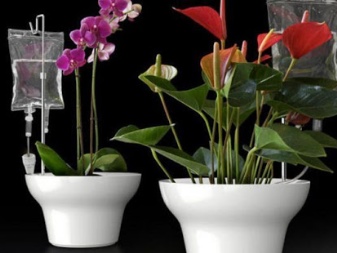
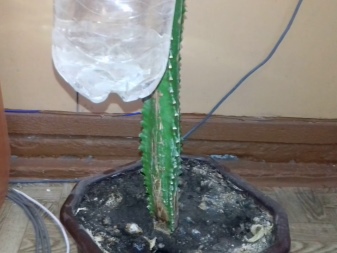
The structure of a glass jar and a towel is suitable for those owners whose home garden is small, and the plants are planted in small pots.
You need to do the following:
- take a shallow pallet of such a size that all your flowers will fit there - if you don't have one, you can use a sink or a bathtub, after plugging the drain hole there;
- put a terry towel moistened with water and wrung out on the bottom of the selected container;
- install pots with plants on it (without pallets so that the drainage holes are open);
- take a large glass jar (from 3 liters), fill it with water, close it with a nylon lid with a previously made hole in it (no more than 1-1.5 cm in diameter);
- close the hole with your finger, turn the jar upside down and set it on a towel;
- if you saw air bubbles rise upward, it means that you did everything right, and the water begins to come out.
When the towel is sufficiently wet, the flow of air will stop, and the liquid will stop leaking out. Conduct an experiment: wring out a towel and put a jar of water on it again, if you see air bubbles again, then your homemade irrigation system is working correctly. It is recommended that this check be done 10 days before the expected departure.
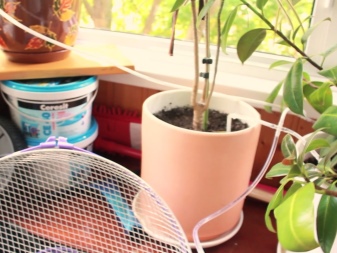
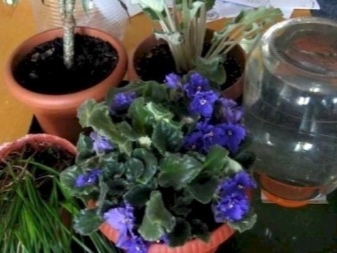
The essence of the method using cotton tapes is similar to irrigation with a dropper, only instead of its tubes you have to use strips of cotton cloth. To do this, you will need an unnecessary pillowcase or sheet that you will not mind tearing.
- So, tear the selected rags into strips - their number should be equal to the number of flower pots.
- Pour water into a large basin, set it on a stool or other hill, arrange pots with plants around.
- Lower one end of the tape into a basin (be sure to the bottom, so you will have to adjust the length of the strips - they should not be short), fix the other inside the soil in each of the pots. Make sure that the strips of fabric do not fall out of the containers, strengthen them carefully: in the basin you can press them down with pebbles, in the pot you can “pin” them with hairpins.
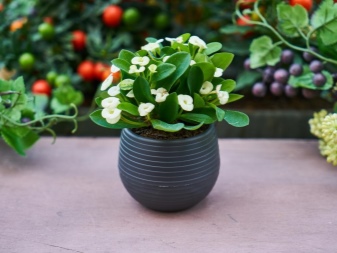
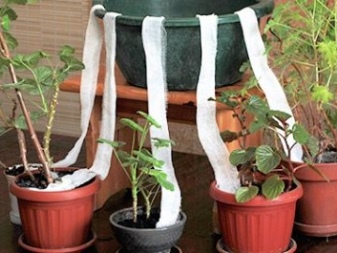
While there is water in the basin, cotton ribbons will pull it, thereby moistening the soil.
Using a hydrogel
An interesting and innovative way to keep plants healthy and provide them with the necessary amount of moisture in the absence of owners is to use a special hydrogel. One gram of this polymer is able to absorb about 250 ml of liquid, and then gradually "release" it into the ground.
There are 2 ways to use the hydrogel:
- place its granules in a flower pot when planting a plant instead of drainage or bury it at a depth of about 20 mm from the surface;
- leave to soak for 8 hours, then arrange in pots and cover with damp moss on top.
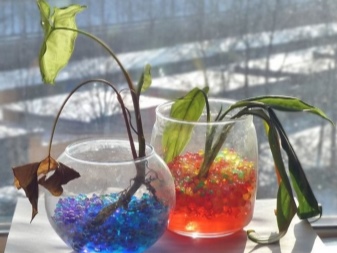
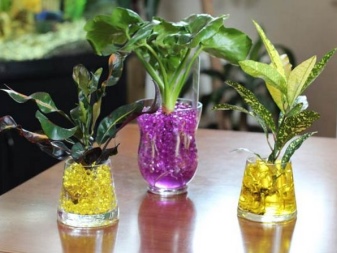
Other Ways to Provide Moisture to Indoor Plants
If you are going to be away for 14 days or less, you can try providing your indoor plants with water without setting up a sophisticated automatic irrigation system.
- Place all the flowers on the floor, next to each other. Water each one liberally. Wrap the pots with wet newspaper sheets, and on top with cellophane wrap - this is done to create high humidity.
- Small plants can be covered with plastic bags or cut-off bottles on top, but be sure to allow air to flow from below.
- If you planted flowers in clay pots, you can do the following: put each pot in a large container and fill the space between their walls with expanded clay balls or moistened moss. In a plastic pot, the same expanded clay can be poured over the soil.
When choosing and installing an automatic irrigation system in an apartment, take the time to study the features of each of your "green pets".
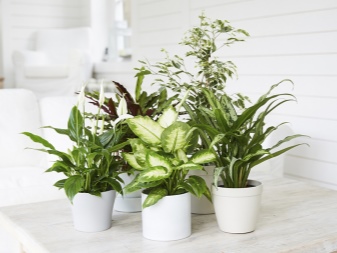
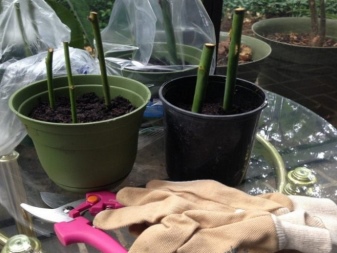
Remember that some of them require almost daily hydration, while others will calmly endure your long absence without any problems and additional manipulations.
How to organize watering of flowers while on vacation, see the video below.












The comment was sent successfully.